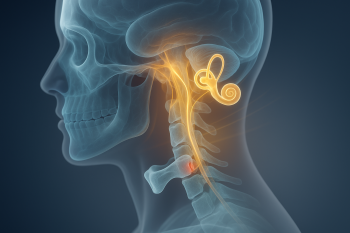
The upper cervical spine is the most complex structural and functional area of the body. The brainstem located inside of the top two bones of the neck controls most functions in the body that we do not consciously control: balance, digestion, muscle tone regulation, blood pressure, heart function, and lung function just to name a few. If you are suffering from Meniere’s disease, or any other chronic condition continues reading to discover how this chronic health issue and others can be caused by an upper cervical spine misalignment due to prior trauma.
Several researchers have shown that when the neck misaligns it interferes with the vestibular center in the brainstem that controls balance. In 2016 a study published in JVSR showed a 90 percent improvement in 300 Meniere’s disease cases that were monitored over a 6-year period. In the following article, we will explain how the upper cervical spine relates to the most common symptoms associated with Meniere’s disease and offer a solution that can help!
By downloading the Digital Patient Chart mobile app you can better control your patient portal.
Common symptoms associated with Meniere’s Disease:
1. Vertigo attacks (often drop attacks)
2. Hearing deficits
3. Brain fog
4. Tinnitus (ringing in the ear)
5. Clogged ear (Eustachian tube dysfunction)
6. Tmd (jaw popping, grinding, or pain)
7. Ear pain
How does a structural misalignment in the neck relate to the symptoms of Meniere’s disease?
VERTIGO
Structural misalignment irritates the brainstem and vestibular nucleus causing the balance centers of the body to malfunction.
Injury to the alignment of the neck joints causes bad. Information relating to the balance centers. Therefore, many who suffer from vertigo find certain head movements trigger their vertigo. This results from bad information inputted into the cord from a joint in the neck that is not moving properly.
CLOGGED EAR (EUSTACHIAN TUBE DYSFUNCTION)
Eustachian tube dysfunction (clogged ear) - muscles lining the Eustachian tube lose their normal tone due to nervous system and brainstem irritation causing the Eustachian tube to close and feel full.
RINGING IN THE EAR (TINNITUS)
Tinnitus - two pub med studies(1) indicate that some tinnitus is the result of a small muscle in the inner ear called the stapedius muscle being in spasm. When this muscle is tight it can cause the dreaded ring we call tinnitus. The stapedius muscle tone is regulated by the brainstem and can be affected by upper neck misalignment.
BRAIN FOG
Brain fog- is highly correlated to a lack of brain blood flow. Upper neck misalignments cause a part of the central nervous system called the sympathetic nervous system to become hyperactive. Increased sympathetic activity decreases brain blood flow reducing cognitive function. We find a high correlation between cognitive function decline and upper cervical spine misalignment.
TMD (temporomandibular joint dysfunction)
The muscles that perform chewing are called the muscles of mastication. Commonly, neck misalignment causes imbalances of mastication muscle tone leading to the TMJ not functioning properly. The muscles of mastication are controlled by the 5th cranial nerve whose nucleus sits inside the brainstem at the atlas-axis level. This imbalance can lead to clicking, popping, and pain in and around the TM joint.
Meniere’s Disease and the Neck – What is the Connection?
We have discussed all of the effects now let’s talk about solutions. Blair upper cervical chiropractors are specially trained to determine if you have an upper cervical spine misalignment that is decreasing the ability of your nervous system to monitor and control normal functions in the body.
Injuries such as car accidents, slip and falls, sports injuries and other blunt-type trauma can cause the upper neck vertebrae to misalign off the joints on the floor of the skull. This structural misalignment can lead to a cascade of effects in the body due to the brainstem and central nervous system being compromised.
When a patient enters a Blair upper cervical doctor’s office a detailed explanation is given to convey the goals of the care (Correct the spinal misalignment and monitor over time), a history is taken, and a battery of tests are run to determine if and where a spinal misalignment is present.
If the patient tests positive for upper cervical spine misalignment a precision cone beam computed tomography (CBCT)scan is taken to determine the exact direction of spinal misalignment that then allows the doctor to know how to deliver a precise force to realign the misaligned segment. Because each patient has unique anatomy and direction of misalignment, it is essential to know the exact direction of misalignment and the angle at which the patient's joint is formed. Once this information is gleaned a precise correction is made to restore normal motion which allows the central nervous system to function better. the correction involves no twisting, popping, or pulling and is made in a neutral side-lying position.
What does the research say about Meniere’s disease and upper cervical spine research?
A researcher out of Grand Rapids Michigan, Dr. Michael Burcon has shown that the upper cervical spine is the epicenter of Meniere’s disease onset. Dr. Burcon published the results of 300 Meniere’s disease cases taken care of in his office in 2016 which showed astounding results.
“Interestingly, all 300 consecutive patients under the researcher’s care were medically diagnosed with Meniere’s Disease (MD) and had also suffered whiplash. This led researcher Dr. Michael Burcon, a leading voice on the topic of chiropractic and MD [3], to comment that the connection was unlikely to be coincidental [2].
“Furthermore,” he remarked, “ninety percent having a listing of posterior and inferior towards the opposite side of the affected ear is significant, as is ninety-seven percent getting their vertigo under control within six weeks [2].”
At the beginning of the process, participants in the study rated their vertigo intensity on a scale of 1 – 10, with 10 being the worse vertigo imaginable. Prior to treatment, the mean score was 8.5. Following the treatment, the averages were as follows:
• After six weeks, 3.0
• After one year, 2.0
• After two years, 1.4
• After three years, 0.9
• At four, five, and six years post-treatment, 0.8
This amounted to an improvement of more than 90%. Of the participants in the study, 97% reported a dramatic improvement in vertigo. Just 3% reported a side effect of a headache. “
The take-home message for anyone suffering from Meniere’s disease is that they should be evaluated for upper cervical spine misalignment with a chiropractor who practices an upper cervical chiropractic technique. Our office right here in Sarasota is one of those offices. Over the years we have seen in excess of 300 Meniere’s disease cases and have seen many lives changed for the better!
References:
[1]https://www.ncbi.nlm.nih.gov/pmc/articles/PMC3629860/#:~:text=Middle%20ear%20myoclonus%20(MEM)%20is,when%20described%2C%20is%20highly%20variable.
[2] Burcon, M (2016), “Health Outcomes Following Cervical Specific Protocol in 300 Patients with Meniere’s Followed Over Six Years,” J Upper Cervical Chiropractic Research, June 2, 2016
[3] Staff Writer Meniere’s Research Institute, (2016), “Meniere’s Disease Breakthrough,” Burcon Chiropractic, http://www.burconchiropractic.com/page/2879








Leave a comment